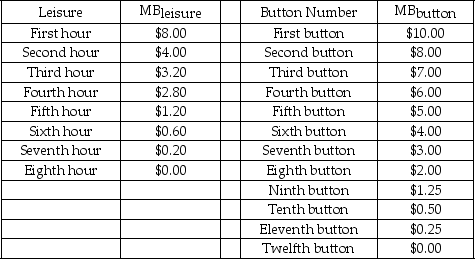Multiple Choice
Scenario: This problem applies the principle of optimization covered in Chapter 5 to the problem of choosing how many hours to work. Paul has to decide how many hours to work per day. His boss is willing to give Paul whatever hours Paul wants up to 8 hours. All else being equal, he would rather not work, that is, Paul has positive marginal benefit from each hour of leisure. But he is an avid collector of presidential campaign buttons. The more leisure he takes, the fewer buttons he can afford. So Paul faces a trade-off between leisure and buttons. Each button costs $1.00. The table below shows Paul's marginal benefits from leisure (MBlₑᵢsᵤᵣₑ) and buttons (MBbᵤttₒn) .

-Refer to the scenario above.If the hourly wage increases from $1.00 to $1.60,Paul would choose to work ________.
A) more hours
B) the same number of hours
C) fewer hours
D) as much as he can (8 hours)
Correct Answer:

Verified
Correct Answer:
Verified
Q80: Scenario: The following figure shows the labor
Q81: Scenario: Mark grows herbs in his backyard.
Q82: Scenario: The labor market in Delaware is
Q83: Sara is a high school graduate,and James
Q84: Other things remaining the same,which of the
Q86: A firm has to decide on the
Q87: The condition determining the optimal amount of
Q88: Scenario: Mark grows herbs in his backyard.
Q89: The following figure shows price versus demand
Q90: Suppose that,on average,women are less likely to